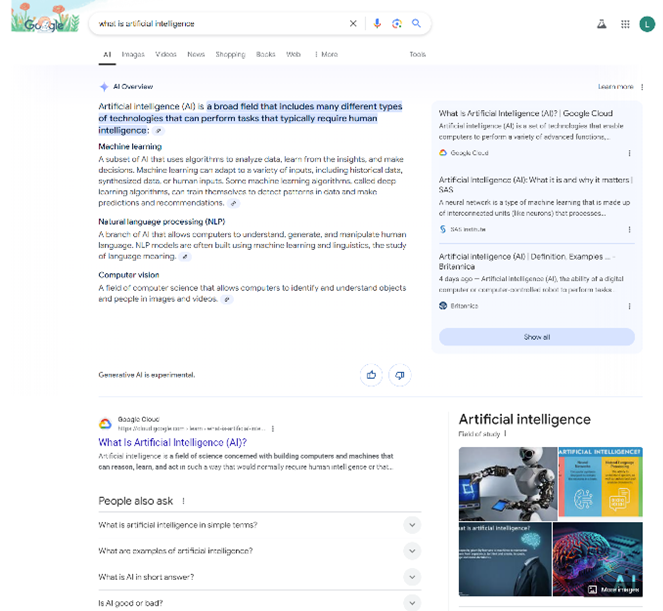
TLDR: In the past six months, most major search engines have launched some form of AI-powered search results feature. These new search features use generative AI systems to compile complete answers to user questions that appear directly on the search results page, reducing the user’s need to click through to a website.
If you’ve asked Google a question any time since mid-May, you might have seen a new feature show up at the top of your search results. Google’s new AI Overview (AIO) is an AI-powered search feature that works to provide quick, complete answers to searchers’ questions directly on the search engine results page (SERP).
AIO was rolled out to the general public on May 14 after being tested by Google and participants in Google Experiments.
Thanks to AIO’s ability to provide users with a complete answer directly on the results page, there will be consequences—both intended and unintended—for the SEO performance of every website on the internet.
In the coming weeks, we’ll be exploring how this new technology works and how it will impact your business’s SEO performance and web traffic. We’ll also look at how M&R Marketing is helping our clients navigate these changes in the world of search and what we’re doing to maintain visibility on this rapidly changing aspect of our work.
This article is the first in a series of three articles about the ongoing introduction of generative AI into the world of search:
- What Is AI Search? (And Other FAQs) <- You Are Here
- What Does the Shift to AI Search Mean For Your Business?
- How is M&R Adapting to the Switch to AI Search
What Is AI Search?
Artificial intelligence, or AI, has been a part of search for a very long time. AI is used in several parts of Google’s “traditional” search algorithms, such as returning helpful responses to mistyped or misspelled queries, interpreting plain language queries (like, “Where is the closest pizza place?”), and in identifying page elements that increase or decrease a page’s ranking in their database.
Where the new AI Overview and other AI search elements differ from these back-end uses are in their use of generative AI, and in the fact that they’re no longer just part of the background. This new front-facing AI feature is the most significant shift to the search landscape in recent history.
What Is Generative AI?
“Generative AI” is a blanket term that refers to a collection of technologies that allow computers to generate (hence, generative) original content instead of simply repeating information verbatim.
Prior to the development of generative AI, computers were helpful for many things, but creating original content was not one of them. Without generative systems, computers are limited to manipulating and returning information that they’ve already been given. They can’t, for instance, write an original answer to the question, “What is the best way to get grass stains out of jeans?” or draw a recognizable picture of, for instance, a “cartoon black and white cat working at a typewriter.”

Pictured: Our resident AI expert
Generative AI is already being used around the world in almost every industry imaginable. If you’ve ever played around with ChatGPT, DALL-E, Google Gemini, or any other recently-released AI platform, you’ve experienced generative AI.
How Does AI Search Work?
Let’s start with a real-life example. Imagine you want to know how to fix a nail hole in your lawnmower tire. You might hop on Google and type in a search along the lines of “How do I fix a nail hole in my lawnmower tire?”
Step 1: “Is This a Question AI Can Answer?”
When you submit a Google search, the search algorithm first “reads” your query and determines what the intent of your search is:
- Are you looking for general information, like a particular fact, instructions for doing something, or advice for managing an issue? You’re performing an informational
- Are you trying to find a particular place on the internet, such as a login page for your favorite social media site? You’re performing a navigational
- Are you shopping for a product or service that solves a particular pain point or meets another need you have, but haven’t decided which product/service to choose? You’re performing a commercial
- Have you made your mind up about your purchase and are looking for the best price or nearest sales location for a particular product/service? You’re performing a transactional
In this case, you’re clearly looking for step-by-step instructions for a process, which means you’re performing an informational search. At the moment, informational searches are more likely than any other type of search to receive an AIO in the results, so just by virtue of the intent of your search, Google knows it may be able to respond with an AI pack.
Google’s system then examines your query and asks itself, “Is this a question I can answer completely and succinctly, using information sources I already have access to?” Since there are a few thousand websites out there with detailed instructions for plugging a hole in a tire, and since doing so involves a definite process with just a few steps, it decides that your search is an excellent fit for an AI Overview.
Step 2: Pages of Research in Just Seconds
Next, the generative AI system sets about answering your question. It starts with information that’s already been stored in the AI’s knowledge base and begins sketching out the framework of its answer.
Following that, it begins scouring the content of thousands of web pages that discuss tire repair, looking for additional information that either reinforces, amplifies, or contradicts the information it’s already pulled from its internal knowledge base. It uses incredibly complicated analysis tools to weigh and evaluate the quality of every information source and then synthesize what it determines to be the highest-quality answer to your specific question. The top 3-7 sources it uses are flagged to become source “cards” in the AI Overview.
Step 3: Returning AI-Generated Results
Finally, your search results page appears. At the top of the page, you’ll see an “AI Overview” icon with a complete AI-generated list of step-by-step instructions for installing a plug in your lawnmower tire. Just below the instructions, you’ll see small rectangular “cards” that contain links to the identified web pages that provided source info*.
Below the AI Overview panel, you’ll continue to see other Google SERP features, like Featured Snippets, People Also Ask, and the Local Pack. In the case of your tire-repair search, a Google Shopping Ads carousel will likely be just below the AIO with ads for tire repair kits, plug cement, and rolls of rubber tire plug stock.
This entire process takes place in just a fraction of a second; searches returning an AIO in addition to organic results are only a tiny bit slower than searches that don’t trigger the AIO pack.
*Source cards have been relocated to the right of the AI Overview on desktop-width devices.
What Does an AI Search Result Look Like?
Note: The look of the AI Overview pack is changing constantly. Since we started writing this article, the layout of the AI Overview on desktop-width devices has already changed at least once.
As of right now, however, the AI Overview pack looks like this on desktop:
On page load:

After expanding the pack:

For most searches that trigger an AIO, the AIO is the first feature on the page. (On rare occasions, a Shopping ad carousel will appear above the AIO.) The AI-generated overview of the search topic appears at the top left. It will usually show up as a summary paragraph, followed by more detailed information.
The AIO will usually appear in its collapsed form with a “Show more” button. On desktop, this means that most AIOs will only appear with the first two source cards visible to the left; the third source card, as well as the “See More” sources button, only appear when the AIO pack is expanded.
As you can see, even with the AIO at its smallest size, on desktop, between the AI pack, a People Also Ask, and an info pack, there’s only room for two organic links above the fold. When you expand the AIO pack to full size, that count decreases to one.
Where Is This AI Search Thing Going?
If you feel like there is still a lot we aren’t sharing about AI, it’s because nobody knows yet. Generative AI is still an incredibly new technology, and how it will ultimately integrate into our daily lives is still being determined. Every common generative AI platform – including Google’s AIOs – is inherently experimental in nature. As each algorithm “learns,” it changes its behavior, and not always in a good way.
Already, SEO professionals are reporting having seen a few big shakeups in the AI search landscape since AIO went live in May. A search topic that’s getting high AI exposure might suddenly see AI vanish from its SERPs.
Google never says why it makes those changes, but we can assume with reasonable confidence that they’re made when the AI begins returning faulty or unhelpful responses to queries. Remember, an AI algorithm is always learning, so a sudden spike in visibility for a specific piece of misinformation can easily cause the error to find its way into an AIO.
AI developers are continually searching for ways to improve their platforms’ abilities to discriminate between good, reliable information and unreliable information. As this work continues, we can expect to see the visibility and prevalence of AI searches to wax and wane both in general and in specific search landscapes.
M&R Has Your Back on AI Search
As we said at the beginning of the article, the introduction of AI Overviews signals the start of a significant shift in the way search engines work. While we’re still in the early days of a transition that could take years to be fully realized, you can rest assured that your partners at M&R Marketing are staying up to date on the latest advances in AI search, how those advances will affect your marketing efforts, and what tactics to leverage to ensure your website, digital ads, and landing pages are getting and maintaining an audience.
More About AI Search:
- What Does the Shift to AI Search Mean For Your Business?
- How Is M&R Adapting to the Switch to AI Search?
Call us today to learn more about how the experts at M&R can create a digital presence for your business that stands out in a sea of competition: 478-621-4491
Detailed Marketing Deets
Want some profound insight into all things marketing? Check out our Definitive Guide Series for detailed information, tips, and advice regarding:

